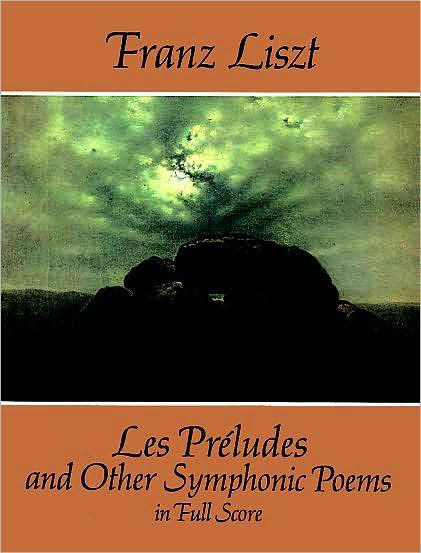Les Preludes and Other Symphonic Poems: in Full Score: (Sheet Music)
This authoritative edition presents full-score reproductions of three of Liszt's best-known symphonic poems. Les Préludes (Symphonic Poem No. 3) grew out of the composer's unpublished choral setting of Joseph Autran's poem "The Four Elements," blending stirring martial music and lovely pastoral themes to make this work the most popular of the symphonic poems. Mazeppa (Symphonic Poem No. 6) evokes Victor Hugo's portrayal of the Cossack leader and the symbolic triumph that comes only after defeat: "He runs, he flies, he falls, and stands up king!" Héroïde Funèbre (Symphonic Poem No. 8) is the last vestige of the monumental Revolutionary Symphony, planned but never completed, suggesting universal brotherhood: a fine, heroic, dignified funeral march.
In these richly sonorous works, Liszt explored the concept of the one-movement "transformation of themes," an approach to composition that Wagner would carry forward in his development of the leitmotif. Liszt's expanding chromaticism would be no less influential, anticipating the twentieth century's embrace of atonality. Frequently performed favorites of audiences around the world, these three works are reprinted from the original Breitkopf & Härtel edition.
"1106523597"
In these richly sonorous works, Liszt explored the concept of the one-movement "transformation of themes," an approach to composition that Wagner would carry forward in his development of the leitmotif. Liszt's expanding chromaticism would be no less influential, anticipating the twentieth century's embrace of atonality. Frequently performed favorites of audiences around the world, these three works are reprinted from the original Breitkopf & Härtel edition.
Les Preludes and Other Symphonic Poems: in Full Score: (Sheet Music)
This authoritative edition presents full-score reproductions of three of Liszt's best-known symphonic poems. Les Préludes (Symphonic Poem No. 3) grew out of the composer's unpublished choral setting of Joseph Autran's poem "The Four Elements," blending stirring martial music and lovely pastoral themes to make this work the most popular of the symphonic poems. Mazeppa (Symphonic Poem No. 6) evokes Victor Hugo's portrayal of the Cossack leader and the symbolic triumph that comes only after defeat: "He runs, he flies, he falls, and stands up king!" Héroïde Funèbre (Symphonic Poem No. 8) is the last vestige of the monumental Revolutionary Symphony, planned but never completed, suggesting universal brotherhood: a fine, heroic, dignified funeral march.
In these richly sonorous works, Liszt explored the concept of the one-movement "transformation of themes," an approach to composition that Wagner would carry forward in his development of the leitmotif. Liszt's expanding chromaticism would be no less influential, anticipating the twentieth century's embrace of atonality. Frequently performed favorites of audiences around the world, these three works are reprinted from the original Breitkopf & Härtel edition.
In these richly sonorous works, Liszt explored the concept of the one-movement "transformation of themes," an approach to composition that Wagner would carry forward in his development of the leitmotif. Liszt's expanding chromaticism would be no less influential, anticipating the twentieth century's embrace of atonality. Frequently performed favorites of audiences around the world, these three works are reprinted from the original Breitkopf & Härtel edition.
19.95
In Stock
5
1

Les Preludes and Other Symphonic Poems: in Full Score: (Sheet Music)
320
Les Preludes and Other Symphonic Poems: in Full Score: (Sheet Music)
320(Breitkopf & Hartel edition)
$19.95
19.95
In Stock

Product Details
| ISBN-13: | 9780486283227 |
|---|---|
| Publisher: | Dover Publications |
| Publication date: | 12/07/1994 |
| Edition description: | Breitkopf & Hartel edition |
| Pages: | 320 |
| Product dimensions: | 9.38(w) x 12.19(h) x 3.18(d) |
About the Author
From the B&N Reads Blog
